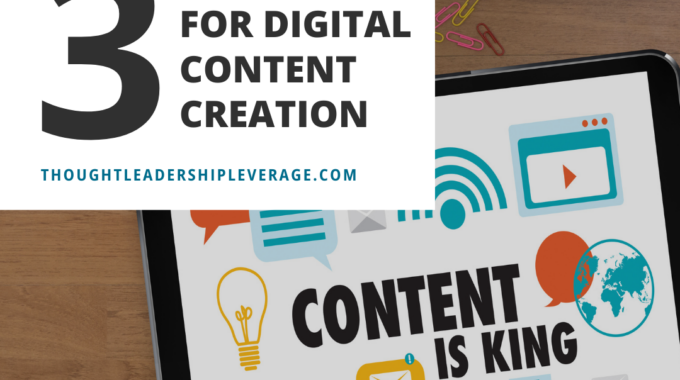Hey there, thought leaders! Ready to level up your digital content game and make some…
Can You Clearly Articulate the Impact of Your Work?
 I’m often confused when talking to authors and thought leaders when I ask them to tell me how their work impacts the lives and businesses of their clients. Many times they’ll immediately dive into a thorough explanation of models, processes and the latest iteration of the work they do. Other times I’ll get an update on research they’ve done that further validates a theory they’ve had or a new theory that they are focusing on. These are all good things, but there’s a big difference between creating something powerful and being able to clearly and concisely communicate the impact of your work to clients and prospects.
I’m often confused when talking to authors and thought leaders when I ask them to tell me how their work impacts the lives and businesses of their clients. Many times they’ll immediately dive into a thorough explanation of models, processes and the latest iteration of the work they do. Other times I’ll get an update on research they’ve done that further validates a theory they’ve had or a new theory that they are focusing on. These are all good things, but there’s a big difference between creating something powerful and being able to clearly and concisely communicate the impact of your work to clients and prospects.
There’s often a gap between what is of interest to the thought leader and the needs of a client or prospect. Clients are concerned about the struggles and business issues at hand and they express an interest in your work (for the most part) not out of intellectual curiosity but out of a need to determine if your work can help them resolve those struggles and issues. Organizations pay for training and learning solutions not so that they can make their employees smarter for the sake of being smarter, but so that employees can use that knowledge in a way that has a measurable impact on the business. If you’re not sure about the impact your work has I’d suggest that you take the time you need to be able to articulate the impact effectively.
One of the easiest ways I’ve found to do that is to ask what is it that you hope people will be able to do, think, act, behave or believe differently as a result of consuming your content? There is usually more than one answer to this question. Once you’ve answered that question the next question is: Given that my client will be able to do X differently, what impact does that have on them as an individual? As a team? As an organization? This may seem a bit overly simplistic but the reality is it’s better to start by being able to simply and clearly state the impact that your work can and does have on your clients as opposed to diving in deeply into the “how” of your work.
Regardless of how novel, interesting, innovative or fascinating your work is, if it can’t be bridged to a measurable, sustainable behavior change that drives a business result, it will remain a “nice to have” versus a “must have” in the eyes of your clients.
Comments (10)
Comments are closed.





I could only smile when I read, “There’s often a gap between what is of interest to the thought leader and the needs of a client or prospect,” because it’s so true! I love the questions you offer as ways to close that gap. It forces us to get out of our heads and into our clients’. When we can experience the problem from their vantage point, we can begin to provide value through content that speaks directly to their needs (and not our somewhat ego-driven expertise). Good stuff! 🙂
Peter, this post is so spot on!
My key question, to myself and to clients: “What significant, beneficial difference will that make?” If our words and our work don’t impact in quantifiable results (either or both qualitative and quantitative), then I say we’re like the supply teacher at school: novel, interesting, fun, a change of pace, informative, but without lasting impact…in, out and gone.
In addition, it’s important for the client to clearly articulate THEIR intention. Sometimes it’s the “I don’t know what I don’t know” conundrum for the client: they want change, they want results, they just might not, at the outset, know what those are. So many people are so good identifying what they DON’T want. When I ask the question (and I do): “Can you articulate clearly to me what it is you want, and what you want to achieve?”, I often get the “well, I don’t want this and I don’t want that…”
When I work with people, we begin with the end in mind: what significant, beneficial difference will this make? How will you do things differently and better as a result of our working together? It’s one thing to know something: the real litmus test is in the doing. Your final paragraph sums it up beautifully! Cheers! Kaarina
I really enjoyed this article, and I will be sharing it. I believe that so often we spin our wheels trying to pitch ALL of the benefits we believe our product has without considering which is the most relevant to our customer. What is the consistent tie that all of our customers have that will benefit from our product? If you can define that clearly you can succeed at the idea of a “must have” product.
Amy McDonald
@REKRUTR
It’s difficult for creatives to focus on outcomes. In our busy world, the old WIIFM question is more crucial than ever.
Peter…simply brilliant. We are working directly in this gap…and the discoveries have been profound and a bit shocking.
We teach 2 truths:
1) actions speak louder than goals, and
2) we are what we repeatedly do.
And, 2 lies:
1) people know what to repeatedly do, and
2) people won’t quit if it’s important.
WRONG.
Sadly, naively, expensively…people generally don’t know how to apply what you’ve taught them, and we’ve found that 97% will quit within 6 months. So if you are writing, teaching, training…and you are NOT comfortable knowing that only 1 in 30 will actually apply what you teach…consider these simple, free tips:
1) translate all theories into recurring, simple actions;
2) don’t go for permanent change, but rather focused sprints of 4-12 weeks
3) help uncover cues and intrinsic rewards to to performing these actions
4) suggest hardwiring environmental reinforcement (accountability coach or partner, track the behavior, share the results)
It’s all about execution. Thoughts and theory without execution are simply entertainment.
Run hard,
Travis
Very interesting post peter. But the biggest challenge that most thought leadership marketing initiatives face is that they typically have a longer gestation period before they can show a clear business impact & more often than not clients expect quick results & hence dong completely invest time, effort money in sustaining a project & hence may not end up getting desired results & blame the thought leadership marketing program instead! So I believe thats the challenge for thought leaders to show value they have generated to clients!
Peter – I really enjoyed your post. I’m working on a #thoughtleadership strategy for a mid-sized educational charity. I’m definitely thinking about how succinctly the org. can articulate its impact on students, teachers, policy, and the broader community.
This is an issue the performing arts has faced for about 100 years, primarily because in much of the West the outcome reality (and desires, if remembered) is undervalued as essential element for fundamental human existence. It’s often just “too hard” for consumers to be bothered with, and therefore any impact the performing arts have on us seems to be a “nice to have” bit of distracting “entertainment,” when the reality is quite the opposite! I’m glad to see many of the comments above reiterate a struggle with… “lethargy” in consumers.
I have a slightly different view. If the person happens to be an author, there is no one way their work will affect someone. It will affect each reader differently. That’s part of the magic of books. You can’t apply this method to art.
I may be coming from a different realm than quite a few authors, but my book definitely speaks of results. It is a tool which is used to help pinpoint emotional effects on the reader’s behavior and is something that creates leverage for the therapist or counselor. Knocking on doors of counseling and behavioral establishments is working to open the way so far, because it addresses a daily struggle, especially in the line of problematic child behaviors (which are not typically bad, but confusing to most therapists, teachers and parents alike). But it is a journey of door-knocking, which becomes more fun as I go along. Like my publicist told me “Everyone is needing help with something and this is what is to be targeted”. Great post Peter!